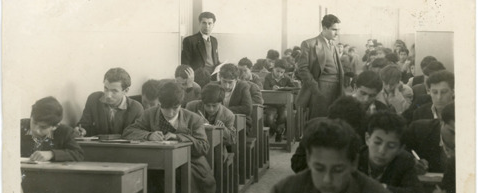THE JAAFARIA COLLECTION

The Jaafaria collection consists of more than 5000 items, including photographs, papers and documents dating between 1920 and 1982. The collection documents various aspects of the social and political history of the southern Lebanese city of Tyre, as well as the history of Jaafaria College (founded in 1938 – official registration in 1941). The College rapidly expanded in the mid 20th century, becoming the first major school south of Sidon to offer secondary level education for girls and boys and the undisputed leading educational institution in this region.
The collection includes personal photos and documents of the school’s founder, Imam Sayyed Abdel Hussein Charafeddine (1872-1957 – also written as: Abd al-Husayn Sharaf al-Din, or Sharafeddin), who was the region’s leading Shiite religious scholar and a prominent figure in the community. The collection also features the personal photos of his son Jaafar, who played a major role in developing the school and was a prominent local politician, managing to get elected to parliament three times in a row, serving as a deputy between 1960 and 1972.
THE PHOTO COLLECTION
The photo collection features students, teachers, and administrators engaging in all types of college daily life and activities, including sports and leisure activities, community events, political rallies, religious festivities and rituals, cultural and social events, local and international political leaders visiting the Jaafaria College or the city of Tyre, outdoor photographs that document the landscape of the city and its neighborhoods at that time, indoor photographs that show us what the interior of the Jaafaria looked like, and photos taken inside various homes in the neighborhood that provide insights into interior design and decoration trends (furniture, etc.).
The collection also contains photos of Sayyed Abdel Hussein Charafeddine making public appearances, engaging in activism, etc., and others from his early life, including several taken during his religious educational years in Najaf/Iraq.
Moreover, the photos demonstrate that modern clothing became prevalent early on (before becoming the norm in the sixties) and that children were encouraged to engage with arts, sports, theater and music classes. The photos also attest to the fact that parents and elders encouraged their children and younger kin to embrace modernity and expand their horizons, as well as to a burgeoning national and sectarian diversity in both students and teaching staff at the Jaafaria College.
Part of the collection features photos taken by the only 3 professional photographers working in Tyre at the time, Darwish Darwish, Rayyes Soussi, and Mohamad Turjouman.
نبذة عن مجموعة الجعفرية
تضمّ مجموعة الجعفرية أكثر من 5000 مادة من صوَر وأوراق ووثائق يعود تاريخها إلى الفترة الممتدّة ما بين 1920 و1982. وتوثّق هذه المجموعة جوانب متعدّدة من التاريخ الاجتماعي والسياسي لمدينة صور، إلى جانب تاريخ الكليّة الجعفريّة (التي تأسست في 1938 وتم تسجيلها رسميّاً في 1941). وكانت الكليّة قد عرفت توسعاً سريعاً في منتصف القرن العشرين لتصبح الكليّة الأولى في منطقة جنوب صيدا التي تقدّم مستوى التعليم الثانوي للبنات والبنين، وهي سرعان ما أصبحت المؤسسة التعليمية الرائدة من دون منازع في المنطقة.
والمجموعة تتضمّن صوراً ووثائق شخصية تعود إلى مؤسس الكليّة الإمام السيد عبد الحسين شرف الدين (1872-1957)، عالم الدين الشيعي الأبرز في المنطقة وواحد من أصحاب القامات البارزة في تلك الفترة.
كذلك تنطوي على مجموعة من الصور الشخصية لنجله السيد جعفر شرف الدين، الذي اضطلع بدور هام في تطوير الكليّة، كما كان من الشخصيات السياسية البارزة محلياً، وقد انتُخب نائباً في البرلمان اللبنانيّ ثلاث مرات على التوالي بين 1960 و1972.
توصيف الصور
وتشتمل مجموعة الصور على طلاب ومعلّمين ومسؤولين إداريين عملوا في أنشطة الكليّة اليومية بما فيها الأنشطة الرياضية والترفيهية، والفعاليات المجتمعية والثقافية، والتجمعات السياسية، والاحتفالات الدينية، والاهتمام بزيارات القادة السياسيين المحليين والدوليين للكلية الجعفرية أو لمدينة صور. كذلك هناك صوَر للمناظر الخارجية التي تمنحنا لمحة عن مشهدية المدينة وأحيائها في ذلك الوقت، وصور لداخل حرم الكليّة وداخل عدد من البيوت في الأحياء المجاورة، بما يظهر لنا التصميم الداخلي وديكور البيوت (أثاث وغيره) آنذاك. كما تتضمّن المجموعة صوراً للإمام السيد عبد الحسين شرف الدين بما فيها صور من شبابه وطفولته وسنوات تعلّمه الدين في النجف بالعراق. كما يوجد العديد من الصور لابنه جعفر مع شخصيات أخرى بارزة، إلى جانب صور له مع أفراد عائلته وأقربائه والخ.
كما تظهر الصور أن الملابس العصرية كانت معتمدة مذّاك (قبل أن تسود في الستينات)، وأن الأطفال كانوا يُشجّعون على الاهتمام بالفنون، وممارسة الرياضة، وحضور صفوف المسرح والموسيقى. وتُعتبر هذه الصور خير دليل على أن الأهل وكبار السنّ كانوا يتقبّلون نسبياً واقع الازدهار الذي عرفه التنوّع الوطني والطائفي على صعيدي الطلاب والطاقم التعليمي في الكليّة الجعفرية.
ويضمّ جزء من المجموعة صوراً بعدسة المصوّرين الثلاثة المحترفين الوحيدين في ذلك الوقت في مدينة صور: درويش درويش، وريّس سوسي، ومحمد ترجمان.
أُخذت البيانات الوصفية في معظمها من المعلومات الموجودة على قفا الصوَر. غير أن فريق "أثر" يعمل على فحصها وتصحيحها حين يلزم الأمر، أو يستكمل المعلومات المفقودة من خلال الاستعلام عنها من أفراد من المجتمع المحلّي.
ونودّ هنا أن ندعو زائري الموقع إلى أن يزوّدونا بأية ملاحظة لديهم تتعلق بدقّة وصف الصور من حيث هويّة الأشخاص وتحديد الأحداث والأماكن والتواريخ.
ملاحظة: طلب منا بعض أصحاب المجموعات الخاصة تشويش وتغطية صور معيّنة لأسباب تتعلق بالخصوصية. إلا أن هذه الصور متاحة للباحثين الذين يزورون مركز أثر.
توصيف الأوراق والوثائق
تغطي الأوراق وثائق ومنشورات صادرة عن الكليّة ما بين تأسيسها في 1938 و1982.
تتضمّن الوثائق جزءاً من أرشيف الكليّة الإداري، والتقارير السنوية التي تصف الأنشطة وتُدرج أسماء المتبرّعين للكلية وقيمة كل تبرّع، وكذلك الكتب السنوية للكلية التي تشتمل على أسماء الطلاب وعلاماتهم، ونصوص الكلمة السنوية التي يلقيها المدير، والوثائق التعريفية الخاصة بالكليّة والطلاب، والنشرات الترويجية التي تصف رسالة الكليّة وبرامجها.
وإذ تعتبر هذه الوثائق خير دليل على مستوى الكليّة وقيمها وأهميتها، فإنها تسلّط الضوء على دور الجالية والنخب المحلية من الطائفة الشيعية خلال تلك الحقبة، ومساهماتهم في تعزيز الظروف الاجتماعية لمحيطهم. وهي تستعرض الصور والوثائق التي تعكس البيئة الفكرية والثقافية والسياسية المزدهرة لهذا المجتمع.
